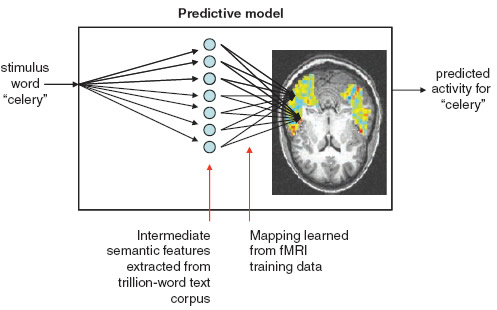Mind Reading Progress

Reading a person’s thoughts may still be science fiction, but researchers at Carnegie-Mellon University are making surprising progress in specific types of “mind reading.” The team, led by computer scientist Tom Mitchell and cognitive neuroscientist Marcel Just, has demonstrated that they can correctly determine the concrete noun subjects are thinking three out of four times:
The team started with the fMRI patterns for 60 concrete nouns, including words for animals, body parts, buildings, clothing, insects, vehicles and vegetables. They then had their computer statistically analyze texts totaling more than 1 trillion words. For each noun, it calculated how frequently it occurs in the text with any of 25 verbs that have sensory or movement meanings, such as see, hear, listen, taste, smell, eat, push, drive and lift. The computer model combined the two sets of data to predict the activation patterns for thousands of concrete nouns, and racked up an accuracy of 77 percent.
“We believe we have identified a number of the basic building blocks that the brain uses to represent meaning,” said Mitchell in a statement. “Coupled with computational methods that capture the meaning of a word by how it is used in text files, these building blocks can be assembled to predict neural activation patterns for any concrete noun.”
A big reason this seems to work is that, as Just explained, people “are fundamentally perceivers and actors. So the brain represents the meaning of a concrete noun in areas associated with how people sense it or manipulate it. The meaning of an apple, for instance, is represented in brain areas responsible for tasting, for smelling, for chewing. An apple is what you do with it.” [From Newsweek.com Lab Notes: Mind Reading: Another Step Closer by Sharon Begley.]
The story details the many limitations of the current work. Verbs and other less concrete words can’t yet be identified, nor can the context of the thoughts be determined. Still, it seems possible that even this level of noun identification might evolve into a useful neuromarketing technique for specific applications.
The paper describing the work appears in Science: Predicting Human Brain Activity Associated with the Meanings of Nouns. The full text is visible here.
